A Gneiss View
The Northwest Highlands' unique panoramas
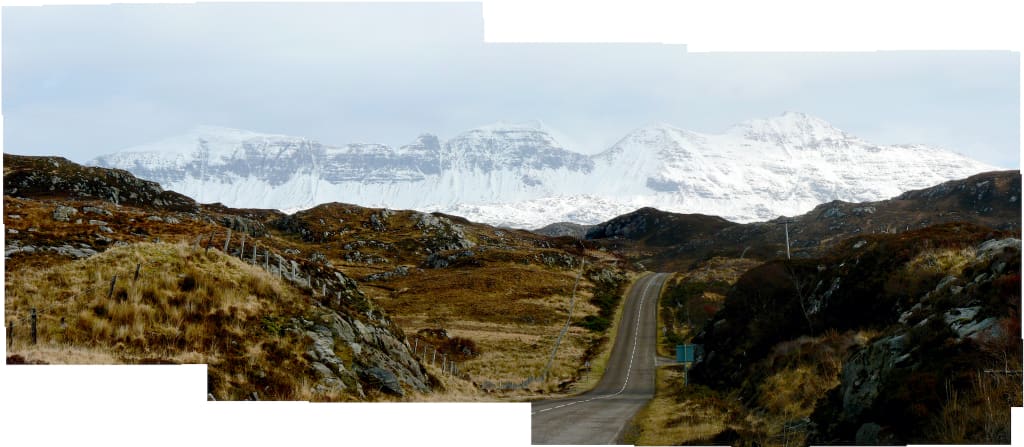
It was a bright day in early March, the sun was shining and a substantial fall of fresh snow lay pristine under an arching blue sky. I stepped off the train at Lairg, midway along the branch line that winds its way from Inverness to Wick in the far north of Scotland and wondered whether the postbus would be in the station car park or somewhere between where I stood and Lochinver, lodged up to its headlights in snow.
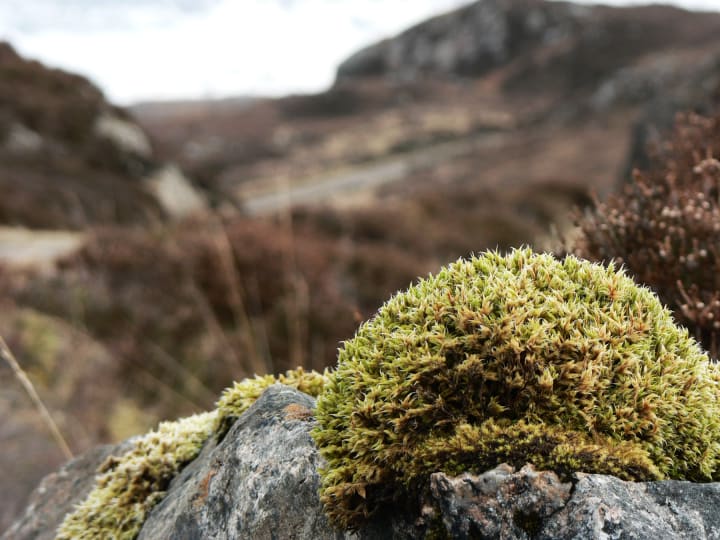
I counted myself lucky to be greeted by Donald and his postbus. The morning collection in Lochinver was, by his account, a little hairy - he had to take several runs at the hill out of the village and nearly didn’t make it at all - but he got through to Lairg in the end and by the early afternoon, with a slight thaw under way, we were soon heading off on the final forty miles of my journey to the top left hand corner of Scotland.
I was on a simple expedition; to find Britain’s oldest landscape and I could not have picked a better day for it. For one thing, everything assumes unfamiliarity in the snow - the world is turned on its head, with the known now unknown, the commonplace ripe and ready for discovery. As a newcomer, with every twist and turn of the road a new experience, the snow added intrigue to every moment of the journey - a sense of an approaching surprise, an imminent unveiling, never resolved in its entirety. It also made everything seem quiet, quiescent and still, tucked up under the snow; the absolute antithesis of its own creation - of all our creations - a brimstone fuelled and filled affair, a sulphurous, acrid hell or a million year monsoon, the various infernos and Biblical deluges that started the world.
Between Hadean wrath and the day's stillness the Highlands had not simply ground to a halt. Far from it, the Scotland I was travelling to was at the centre of enormous turbulence in the Earth’s formative history and then again over two and a half billion years later and I was going there on a mission to uncover some of this chaos anew; that was my imminent unveiling.
The postbus barrelled through the ancient mountains of Sutherland, down the single track road to Inchnadamph and beyond. Our forty mile drive was almost wholly over one feature that boiled the brains of Victorian geologists for over fifty years, but I was heading for the strip of land beyond - towards a landscape that holds a fascination all of its own.
Despite the thaw, as we made our way up Strath Oykel there was still plenty of snow around and that was good news for any expedition for which the operational parameters boil down to ‘look at the ground’ because in those circumstances, snow, as Donald observed, “reveals more than it conceals”.
He was right in that the overall structure of things becomes more visible when detail is obscured in this way; in such conditions, for example, the thin horizontal terraces that girdle the mountains are picked out like the lines of ribbing on a gargantuan airship. Reduced to its essentials, snow-bound scenery is an invitation to explore the grand line of nature, the sweeping statement of a landscape rendered by brute force on a planetary scale.
As the bus trundled on, a quick glance at the Ordnance Survey underlined the daunting beauty of the terrain. Feinne-Bheinn Nhor, Coigach, Cul Mor, Quinag and Suilven; the names of drafty peaks came howling from the map like disconsolate wails. Lochs Glendhu, Borralan, Urigill, Culag and Bad a´Ghail, too, sounded like Tolkein’s placenames, but the scenery outside the bus was of even more epic proportions. Even a lone stag, magnificently and picturesquely framed on the skyline like a commercial for whisky, water or life assurance, failed to draw my eye for long before it was pulled back to the matter in hand, the potency of the land itself.
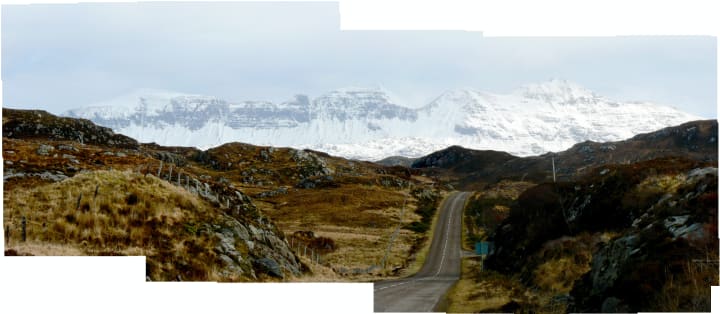
West of the road that connects Inchnadamph, Stronchrubie and Knockan Crag, with Durness to the North and Ullapool to the south, that power began to become apparent. Here lies some of the basement rock of Britain – a slab of crust two thirds the age of the planet on which the entire edifice of Scotland is presumed to rest. This group of rocks - the Lewisian Gneisses - were originally another type of rock altogether and were changed into the form we see today by enough heat and pressure to recrystallise, but not melt, them. They are amongst the oldest rocks in the world and, because they are metamorphic, the Lewisian Gneisses were formed under intense pressure, somewhere deep, perhaps thirty miles, underground within the crust. From a distance they look a little like granite, but at close quarters they have a distinctive, banded appearance, their alternating dark and light stripes a by-product of their particular formation under extreme heat and pressure. Under the conditions in which the rocks of the Lewisian Complex were formed, minerals that make up the rock were separated out and arranged themselves into alternating layers - the higher density minerals are dark while those of less substance form paler bands within the rock. In places, the stripes twist and turn, squeezed this way and that under monumental force as if the rock once had the structural integrity of toothpaste.
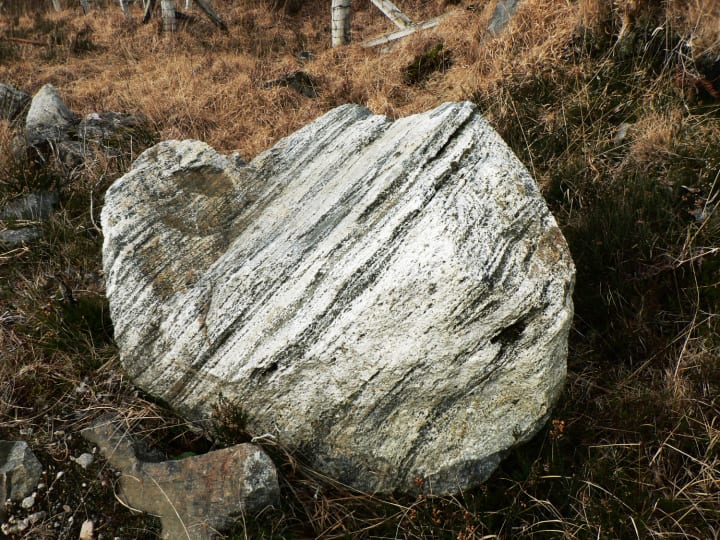
Donald pointed here and there as he told countless stories from the Highlands. Of bank robbers holed-up in isolated shacks; the village bobby turned part-time poacher; and the old lady from Caithness who fought off a military rescue team with a broom during the 1947 blizzard because she believed her rescuers were from another planet.
In a sense the old lady from Caithness was right, though perhaps not in the way that she thought. Contrary to appearances, the military rescue team - arriving in their insectoid helicopters wearing jumpsuits and helmets with visors - were from planet Earth, after all, but this part of the Highlands looks as forbidding as the landscape of another planet entirely.
Not quite though. It is more like an artist’s impression of another planet entirely; one of those quarries where the BBC filmed science fiction in the 1970s. This isn't a quarry for parking the Tardis in; there is something elemental at work and man has had no hand in it at all.
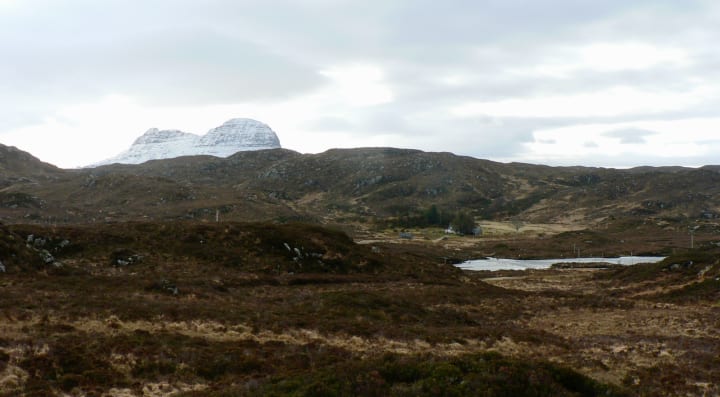
There are rocks everywhere, some of which seem to be scattered around in a casual fashion. The rest of the rock seems to grow from the ground, cropping out from between clumps of poor, peaty earth in rounded pillows that form hundreds of tiny crags and cliff faces, each about 10 feet high. It is one of those rare landscapes, in twenty-first century Britain, that is devoid of all human detail and, because of those little crags, carries off the look of another landscape in miniature, like an ‘00’ scale model of the Peak District.
Once you have arrived in this unique landscape, you may be surprised, as I was, that it feels so ancient, so primeval - as well as alien and elemental. All wilderness has a greater or lesser quality of undomesticated menace about it - as if an absence of human civilisation abrades away our rational thoughts. A human embryo, it is said, has a passing resemblance to all the evolutionary steps taken since our ancient ancestors flipped out of puddles and ponds onto land millions of years ago. Perhaps pre-human landscapes like these feel so old because we recognise them subconsciously and revert to using our paleo brains but, either way, the gneiss is a terrain that plays all kinds of tricks to subtly subvert the expectations of the observer.
You might half expect to see a diplodocus in Loch a´Choireachin, but will have to be content instead with my observations; a pair of Goldeneye and a bright yellow rubber duck thrown in by some local wag.

The gneiss survived an inundation of sand settled out of enormous river systems a billion years ago, a time when there were no complex organisms on the planet – when even the diplodocus was a distant and unlikely possibility. Since then, the elements have stripped away the sandstone to reveal a landscape frozen in prehistory.
The wild, antediluvian North West Highlands are one of the most extraordinary landscapes you are likely to see in these islands and even if you begrudgingly accept that you are on planet Earth, notwithstanding the views of the old lady from Caithness, it certainly doesn’t feel like Britain in the slightest.
About the Creator
Ian Vince
Erstwhile non-fiction author, ghost & freelance writer for others, finally submitting work that floats my own boat, does my own thing. I'll deal with it if you can.



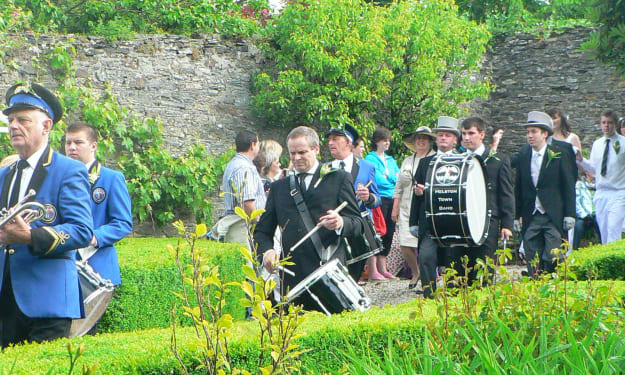

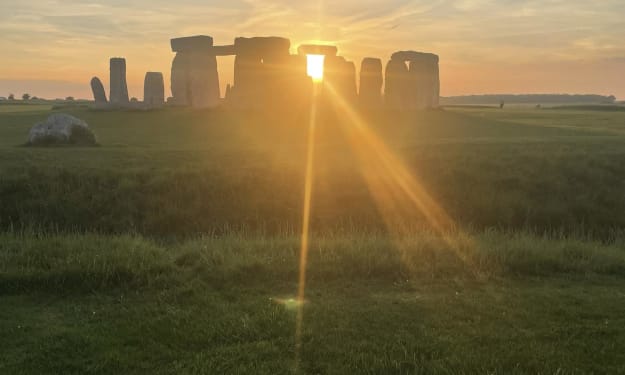

Comments (6)
Newly subscribed! Congratulations on your well earned Top Story!
Congrats on Top Story!
Congratulations on Top Story! 🥳 I love the highlands and have visited a few times. Thank you for bringing me along on this adventure through words and pics. Always love seeing more of these magical places.
Congrats on TS. I loved the photos, living in a mountainous and wilderness area in the U.S.
I felt like i was reading in an alien language, the unpronounce-able names. Sounds like a wonderful trip. Congrats.
The story is very interesting, i was took aback in the journey but i really enjoyed it